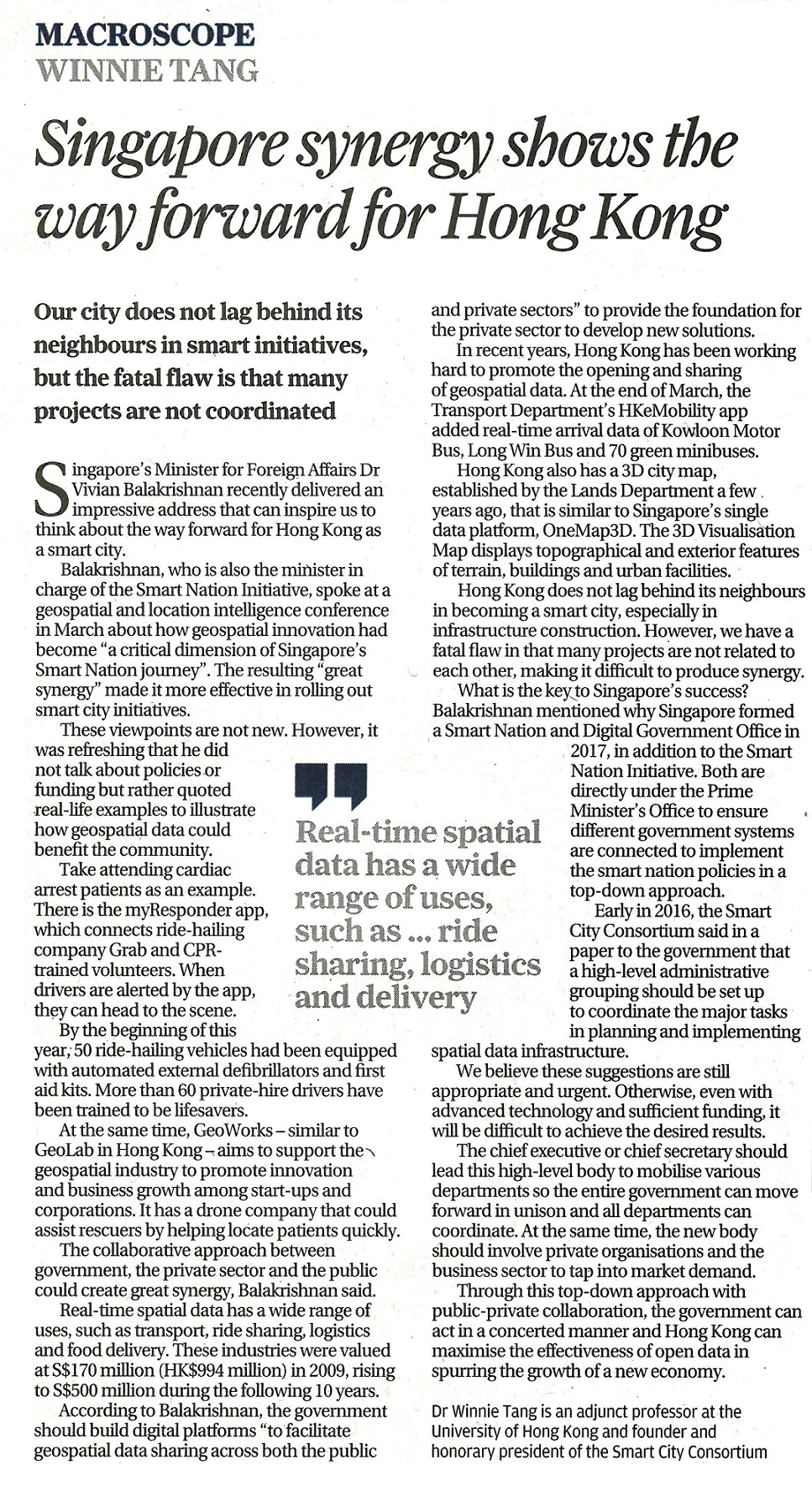網上版請按此

Singapore synergy shows the way forward for Hong Kong
Our city does not lag behind its neighbours in smart initiatives, but the fatal flaw is that many projects are not coordinated
Singapore's Minister for Foreign Affairs Dr Vivian Balakrishnan recently delivered an impressive address that can inspire us to think about the way forward for Hong Kong as a smart city.
Balakrishnan, who is also the minister in charge of the Smart Nation Initiative, spoke at a geospatial and location intelligence conference in March about how geospatial innovation had become "a critical dimension of Singapore's Smart Nation journey". The resulting "great synergy" made it more effective in rolling out smart city initiatives.
These viewpoints are not new. However, it was refreshing that he did not talk about policies or funding but rather quoted real-life examples to illustrate how geospatial data could benefit the community.
Take attending cardiac arrest patients as an example. There is the myResponder app, which connects ride-hailing company Grab and CPR-trained volunteers. When drivers are alerted by the app, they can head to the scene.
By the beginning of this year, 50 ride-hailing vehicles had been equipped with automated external defibrillators and first aid kits. More than 60 private-hire drivers have been trained to be lifesavers.
At the same time, GeoWorks – similar to GeoLab in Hong Kong – aims to support the geospatial industry to promote innovation and business growth among start-ups and corporations. It has a drone company that could assist rescuers by helping locate patients quickly.
The collaborative approach between government, the private sector and the public could create great synergy, Balakrishnan said.
Real-time spatial data has a wide range of uses, such as transport, ride sharing, logistics and food delivery. These industries were valued at S$170 million (HK$994 million) in 2009, rising to S$500 million during the following 10 years.
According to Balakrishnan, the government should build digital platforms "to facilitate geospatial data sharing across both the public and private sectors" to provide the foundation for the private sector to develop new solutions.
In recent years, Hong Kong has been working hard to promote the opening and sharing of geospatial data. At the end of March, the Transport Department's HKeMobility app added real-time arrival data of Kowloon Motor Bus, Long Win Bus and 70 green minibuses.
Hong Kong also has a 3D city map, established by the Lands Department a few years ago, that is similar to Singapore's single data platform, OneMap3D. The 3D Visualisation Map displays topographical and exterior features of terrain, buildings and urban facilities.
Hong Kong does not lag behind its neighbours in becoming a smart city, especially in infrastructure construction. However, we have a fatal flaw in that many projects are not related to each other, making it difficult to produce synergy.
What is the key to Singapore's success? Balakrishnan mentioned why Singapore formed a Smart Nation and Digital Government Office in 2017, in addition to the Smart Nation Initiative. Both are directly under the Prime Minister's Office to ensure different government systems are connected to implement the smart nation policies in a top-down approach.
Early in 2016, the Smart City Consortium said in a paper to the government that a high-level administrative grouping should be set up to coordinate the major tasks in planning and implementing spatial data infrastructure.
We believe these suggestions are still appropriate and urgent. Otherwise, even with advanced technology and sufficient funding, it will be difficult to achieve the desired results.
The chief executive or chief secretary should lead this high-level body to mobilise various departments so the entire government can move forward in unison and all departments can coordinate. At the same time, the new body should involve private organisations and the business sector to tap into market demand.
Through this top-down approach with public-private collaboration, the government can act in a concerted manner and Hong Kong can maximise the effectiveness of open data in spurring the growth of a new economy.
Dr. Winnie Tang
Adjunct Professor, Department of Computer Science, Faculty of Engineering; Department of Geography, Faculty of Social Sciences; and Faculty of Architecture, The University of Hong Kong